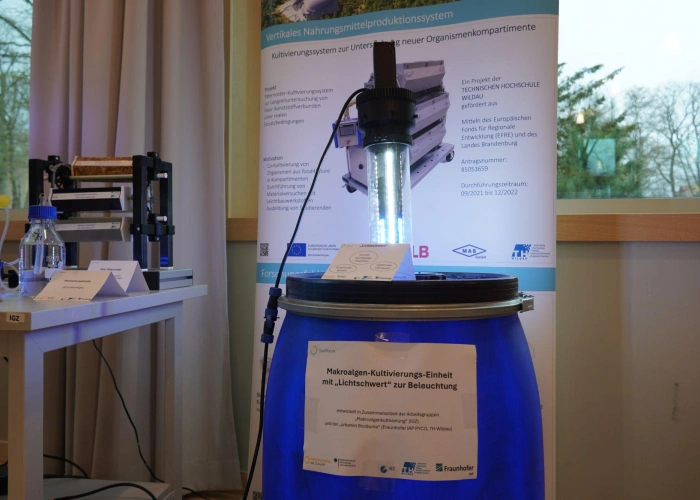Sustainable food source macroalgae - innovation from research

Macroalgae are a promising resource for the food of the future. They grow quickly, require neither fresh water nor arable land and contain a variety of nutrients such as proteins, vitamins and minerals. In the first funding phase of “food4future”, Ulva compressa and Ulva fenestrata - also known as sea lettuce - were successfully identified as model organisms for urban cultivation. Using innovative bio-based materials with functional integration and the use of regional brine water, for example from the Bad Saarow thermal spa, urban cultivation systems for the sustainable indoor production of saline food organisms such as macroalgae, but also halophytes and jellyfish, were developed for the first time.
The second project funding phase builds on this innovative approach.
The previous laboratory samples and pilot projects will be further scaled up to enable commercial use.The focus is on sustainable materials and resource-conserving processes, including the use of renewable energies to minimize environmental impact.The urban, saline indoor cultivation systems will be scaled up to enable greater biomass and ingredient production. Expanded production facilities with a capacity of up to 2000 liters ensure stable and high-quality macroalgae production. In addition to Ulva species, other promising algae species such as Ceramium virgatum are being investigated for their suitability for production and their nutritional benefits. Research also focuses on optimizing the nutrient profiles and value-adding ingredients by adjusting cultivation conditions such as light intensity, temperature and nutrient composition. Particular attention is being paid to the use of UVB LED technologies, which have already shown positive effects on ingredients such as vitamins and antioxidants.
In line with a circular approach, the f4f project is testing how nutrients can be integrated into macroalgae cultivation not only via purified brine wastewater, but also from other residual material streams such as wastewater from shrimp production or salt mining.
This will not only make macroalgae production more resource-efficient, but also more sustainable. In addition, it is being examined how macroalgae can be integrated into co-cultivation with other organisms such as halophytes or microalgae in order to achieve synergies in nutrient use and CO2 utilization.The biomass obtained and the nutrient richness of macroalgae offer a wide range of possible applications:It can be processed into foods such as bread, pasta or snacks and opens up new ways for the food industry to develop healthy and innovative products. In addition, the bioavailability of macroalgae is being tested in order to maximize nutrient absorption in humans. This is done in close cooperation with food4future partners who specialize in nutritional studies.